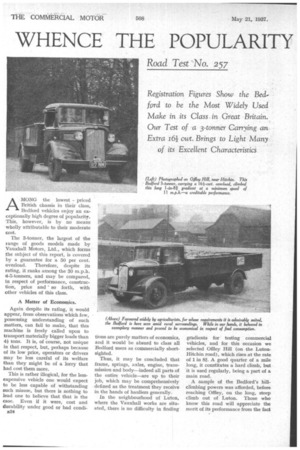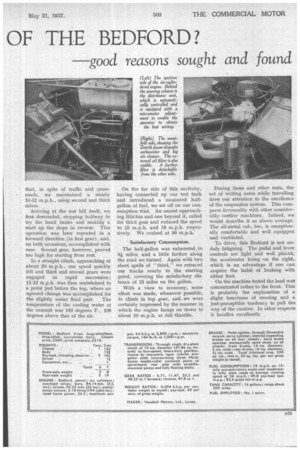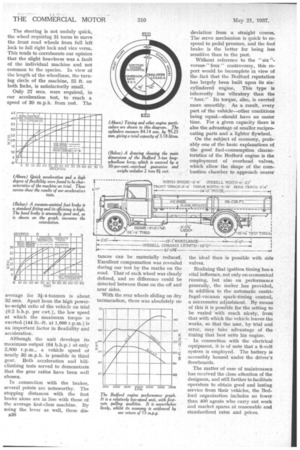WHENCE THE POPULARITY OF THE BEDFORD?
Page 58

Page 59

Page 60

If you've noticed an error in this article please click here to report it so we can fix it.
good reasons sought and found
Road Test No. 257
MONG the lowest priced British chassis in their class, Bedford vehicles enjoy an exceptionally high degree of popularity. This, however, is by no means wholly attributable to their moderate cost.
The 3-tonner, the largest of the lange of goods models made by Vauxhall Motors, Ltd., which forms the subject of this report, is covered by a guarantee for a 50 per cent. overload. Therefore, despite its rating, it ranks among the 30 m.p.h. 4-5-tonners, and may be compared, in respect of performance, construction, price and so forth, with other vehicles of this class.
A Matter of Economics.
Again despite its rating, it would appear, from observations which few, possessing understanding of such matters, can fail to make, that this machine is freely called upon to transport materially bigger loads than 4itons. It is, of course, not unique in that respect, but, perhaps because of its low price, operators or drivers may be less careful of its welfare than they might be of a lorry that had cost them more.
This is rather illogical, for the lessexpensive vehicle one would expect to be less capable of withstanding such misuse, but there is nothing to lead one to believe that that is the case. Even if it were, cost and durability under good or bad condi
tions are purely matters of economics, and it would be absurd to class all Bedford users as commercially shortsighted.
Thus, it may be concluded that frame, springs, axles, engine, transmission and body—indeed all parts of the entire vehicle—are up to their job, which may be comprehensively defined as the treatment they receive in the hands of hauliers generally.
In the neighbourhood of Luton, where the Vauxhall works are situated, there is no difficulty in finding
gradients for testing commercial vehicles, and for this occasion we selected Offiey Hill (on the LutonHitchin road), which rises at the rate of 1 in Sa. A good quarter of a mile long, it constitutes a hard climb, but it is used regularly, being a part of a main road.
A sample of the Bedford's hillclimbing powers was afforded, before reaching Offiey, on the long, steep climb out of Luton. Those who know this road will appreciate the merit of its performance from the fact
that, in spite of traffic and crossroads, we maintained a steady 10-12 m.p.h., using second and third ratios.
Arriving at the test hill itself, we first descended, stopping halfway to try the hand brake and making a start up the slope in reverse. This operation was later repeated in a forward direction (in first gear), and, on both occasions, accomplished with ease. Second gear, however, proved too high for starting from rest.
In a straight climb, approaching at about 30 m.p.h., our speed quickly fell and third and second gears were engaged in rapid succession; 11-12 m.p.h. was then maintained to a point just before the top, where an upward change was accomplished for the slightly easier final part. The temperature of the cooling water at the summit was 180 degrees F., 108 degrees above that of the air.
On the far side of this acclivity, having connected up our test tank and introduced a measured halfgallon of fuel, we set oil on our consumption trial. An ascent approaching Hitchin and one beyond it, called for third gear and reduced the speed to 15 m.p.h. and 18 m.p.h. respectively. We cruised at 30 m.p.h.
Satisfactory Consumption.
The half-gallon was exhausted, in Ge miles, and a little farther along the road we turned. Again with two short spells of "third," we retraced our tracks nearly to the starting point, covering the satisfactory distance of 13 miles on the gallon.
With a view to economy, some effort was made, whenever possible, to climb in top gear, and. we were certainly impressed by the manner in which the engine hangs on down to about 20 m.p.h. at full throttle. During these and other tests, the act of writing notes while travelling drew our attention to the excellence of the suspension system. This compares favourably with other considerably costlier machines. Indeed, we would describe it as above average. The all-metal cab, too, is exceptionally comfortable and well equipped and ventilated.
To drive, this Bedford is not unduly fatiguing. The pedal and lever controls are light and well placed, the accelerator being on the right, which is an advantage if one can acquire the habit of braking with either foot.
On the machine tested the load was concentrated rather to the front. This is probably the explanation of a slight heaviness of steering and a just-perceptible tendency to pull the way of the camber. In other respects it handles excellently
The steering is not unduly quick, the wheel requiring 3i turns to move the front road wheels from full left lock to full right lock and vice versa. This tends to corroborate our opinion that the slight heaviness was a fault of the individual machine and not common to the species. In view of the length of the wheelbase, the turning circle of the machine, 55 ft. on both rocks, is satisfactorily small.
Only 27 secs. were required, in our acceleration test, to reach a speed of 30 m.p.h. from rest. The average for 31-4-tonners is about 32 secs. Apart from the high powerto-weight ratio of the vehicle on trial (0.5 b.h.p. per cwt.), the low speed at which the maximum torque is exerted (144 lb.-ft. at 1,000 r.p.m.) is au important factor in flexibility and acceleration.
Although the unit develops its maximum output (64 b.h.p.) at only 2,800 r.p.m., a vehicle speed of nearly 30 m.p.h. is possible in third gear. Both acceleration and hillclimbing tests served to demonstrate that the gear ratios have been well chosen.
In connection with the brakes, several points are noteworthy. The stopping distance § with the foot brake alone are in line with those of the average first-class machine. By using the lever as well, these dis B26 ta.nces can be materially reduced. Excellent compensation was revealed during our test by the marks on the road. That of each wheel was clearly defined, and no difference could be detected between those on the off and near sides.
With the rear wheels sliding on dry tarmacadam, there was absolutely no deviation from a straight course. The servo mechanism is quick to respond to pedal pressure, and the foot brake is the better for being less sensitive than in the past.
Without reference to the "six versus-" four " controversy, this report would be incomplete in view of the fact that the Bedford reputation has largely been built upon its six-. cylindered engine, This type is inherently less vibratory than the "four." Its torque, also, is exerted more smoothly. As a result, every part of the vehicle—other conditions being equal—should have an easier time. For a given capacity there is also the advantage of smaller reciprocating parts and a lighter flywheel.
On the subject of economy, probably one of the basic explanations of the good fuel-consumption characteristics of the Bedford engine is the employment of overhead valves, which allow the shape of the combustion chamber to approach nearer the ideal than is possible with side valves.
R.ealizing that ignition timing has a vital influence, not only on economical running, but also on performance generally, the maker has provided, in addition to the automatic centrifugal-vacuum spark-timing control, a micrometer adjustment. By means of this it is possible for the setting to be varied with much nicety, from that with which the vehicle leaves the works, so that the user, by trial and error, may take advantage of the timing that best suits his engine.
In connection with the electrical equipment, it is of note that a 6-volt system is employed. The battery is accessibly housed under the driver's floorboards.
The matter of ease of maintenance has received the close attention of the designers, and still further to facilitate operators to obtain good and lasting service from their vehicles, the Bedford organization includes no fewer than 400 agents who carry out work and market spares at reasonable and standardized rates and prices.




































































































